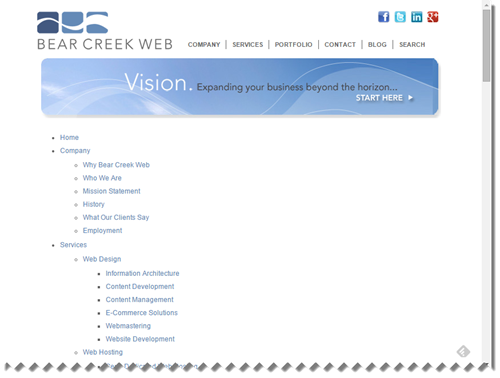While most people are familiar with the use of site maps for website organization, XML site maps provide specific benefits for SEO when compared to the HTML version.
In order to decide whether or not to include an XML site map for your business website, a solid understanding of the pros and cons of each type of sitemap is helpful.
Types of Sitemaps
Most companies are familiar with and already have an HTML site map which includes their most important pages or categories of pages. This HTML sitemap page is often coded to look exactly the same as other webpages on the site, and is primarily used as a guide for new website visitors to find specific pages. Sometimes these HTML sitemaps are static and must be modified when a page is added or deleted to the site, and other times they are dynamic and are automatically updated using PHP or some other scripting language.
By contrast, an XML sitemap is primarily used by search engines. Search engine spiders use the XML sitemap as a guide to crawl each listed page on a website and to get important information on the last time a page was updated or changed. This is particularly important for internal pages that may not have many outside links pointing to them.
The case can be made for most websites to use both HTML and XML site maps. HTML site maps serve an important UX function because visitors do not have to navigate multiple pages to find what they are looking for. Additionally, HTML sitemaps make a great 404 page – if someone types in the URL of a page that no longer exists, they can at least get to the section they were looking for from the sitemap. We typically recommend an XML sitemap to ensure that all content on your business website gets indexed and not just the popular pages.
Is there ever a reason to forgo having an XML sitemap? For people with small, static websites an HTML sitemap may suffice (at least until the business starts to grow and produce more content).
However, it’s well known that regularly updated content has a direct impact on SEO, and at Bear Creek Web we recommend that all websites (even relatively small ones) have XML sitemaps in place from the start to make the process of updating easier and faster as the website grows.
The Most Compelling Reasons to Implement XML Sitemaps
SEO: An XML sitemap reduces the time it takes for search engines to find and rank your webpages pages by giving them a listing of every page within your site.
More frequent crawling: A sometimes-overlooked benefit of XML sitemaps is the ability to include information such as the last time a page was updated. Google and other search engines crawl sites more often when they are regularly updated. Therefore, having an xml sitemap that includes this information helps ensure that search engines are visiting your site regularly to get new and updated content.
This, in turn, means that updates to your pages are pushed out to search engine results listings faster, and potential visitors see the most recent changes you’ve made to your site.
Deeper insights: If your Google Webmaster account is linked with Google Analytics, you will be able to see data on how many URLs have been submitted, and how many webpages Google has indexed from each sitemap.
While XML sitemaps are highly beneficial for SEO, there are a few caveats to keep in mind:
- In order to be accepted by Google, your XML sitemap cannot have more than 50,000 links
- Your XML sitemap also cannot be larger than 50MB in size
- Multiple XML sitemaps are best organized by using a main xml sitemap that links to the rest of your sitemaps.
At Bear Creek Web, we routinely handle our customers XML and HTML sitemap creation, including the organization and updates. If you need help, please contact us.
Examples of HTML & XML Sitemaps
To give you a visual contrast of the two different types of sitemaps, take a look at our HTML sitemaps (meant for people):
 versus our XML sitemap (meant for Google):
versus our XML sitemap (meant for Google):
Your Turn: Are you currently using an XML sitemap for your business? If so, has it helped you get more pages indexed?

